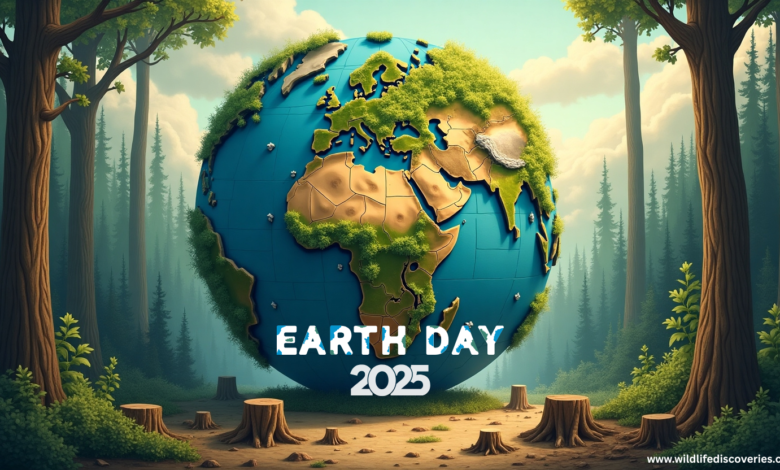Earth Day 2025: Dangers, Climate, Recent Efforts, Help, How to Participate
Earth Day: Unite, Act, Restore

Every year on April 22nd, people all over the world celebrate Earth Day. This day is dedicated to protecting nature and making the planet a better place for both animals and people. One of the biggest problems our planet faces is deforestation—the cutting down of too many trees. When this happens, animals lose their homes, the air becomes more polluted, and the climate changes. If we don’t take action, it could harm our future and the environment we rely on. Earth Day is an opportunity for individuals, communities, and governments to come together and take meaningful steps to preserve our planet. Whether through conservation efforts, education, or policy changes, each effort plays a vital role in making a difference.

Why Trees Matter?
Trees are essential for life. They clean the air, provide shade, and create homes for many animals. However, people are cutting down forests at an alarming rate. When too many trees are removed, it becomes harder for animals to find shelter and food. Trees also play a big role in keeping the climate stable. Without them, the weather becomes hotter, storms become stronger, and dry land increases. Trees also prevent soil erosion, help grow food, and provide fruits and medicines. Protecting trees benefits not just nature but also humans. Beyond their environmental benefits, trees also play a significant role in human culture and history. Many ancient civilizations relied on forests for survival, using wood for tools, shelter, and medicine. Even today, forests continue to provide economic opportunities for people through sustainable industries like eco-tourism and ethical forestry.

Animals in Danger Due to Deforestation
Forests are home to thousands of species, from big cats to tiny insects. But when trees are cut down, these animals lose their homes. Some of the most affected animals include:
- Orangutans – Found in Southeast Asia, these intelligent creatures are losing their forests due to palm oil production.
- Jaguars – Their natural habitat in the Amazon rainforest is shrinking, making it harder for them to find food and survive.
- Birds and Insects – Many bird and insect species rely on forests for food and nesting. When trees disappear, so do these creatures.
- Elephants – These large animals depend on forests for food and water, and deforestation forces them into human settlements, increasing conflicts.
- Tigers – Fewer forests mean fewer hunting grounds, making it harder for them to survive in the wild.
When forests are destroyed, animals are forced to move, sometimes coming into dangerous contact with humans. Protecting forests means saving the many creatures that call them home. Many conservation groups are working hard to protect endangered animals through breeding programs, habitat restoration, and strict anti-poaching laws.

How Deforestation Affects Climate?
Trees play a huge role in keeping the Earth’s temperature balanced. They absorb carbon dioxide, which helps slow down global warming. When too many trees are cut down, more carbon stays in the air, making the planet hotter. This leads to:
- More extreme weather, including stronger storms and heatwaves.
- Rising sea levels as ice melts in colder regions.
- More wildfires, as dry areas become even drier.
- Changes in farming, making it harder to grow food.
- Less clean air, as fewer trees means less oxygen production.
Saving trees can help keep the planet cool and protect people from extreme weather. Scientists and environmentalists are warning that if deforestation continues at its current rate, global temperatures could rise to dangerous levels, leading to catastrophic effects on ecosystems and human societies alike.

Recent Efforts to Save Forests
People, governments, and organizations around the world are working hard to stop deforestation. Some recent efforts include:
- The Trillion Trees Initiative – A global effort to plant a trillion trees and restore forests.
- Stronger Laws – Some countries have created strict rules to stop illegal tree-cutting and promote sustainable forest management.
- Eco-Friendly Businesses – More companies are choosing to use recycled materials and sustainable wood to minimize environmental damage.
- Protected Areas – Governments are expanding national parks and reserves to safeguard forests and prevent further deforestation.
- Community Projects – Local communities and schools are engaging in tree-planting initiatives and educating people about forest conservation.
- Sustainable Farming – Farmers are being encouraged to adopt eco-friendly techniques such as agroforestry, crop rotation, and organic farming to reduce the need for deforestation.
- Reforestation Programs – Organizations are working to replant trees in areas where forests have been cleared, helping to restore biodiversity and maintain ecological balance.
- Carbon Offset Programs – Many businesses are investing in reforestation projects to compensate for their carbon emissions and promote a greener future.
- Technology and Innovation – Scientists are using satellite imagery, drones, and artificial intelligence to track deforestation patterns and enforce conservation laws more effectively.

What You Can Do to Help?
Everyone can take steps to help stop deforestation. Here are some simple ways to make a difference:
- Use Less Paper – Choose digital options or recycle paper products.
- Support Sustainable Brands – Buy products that are made in eco-friendly ways and avoid those linked to deforestation.
- Plant More Trees – Join tree-planting events or grow plants in your backyard to contribute to reforestation efforts.
- Reduce Meat Consumption – A lot of forests are cleared to make space for cattle. Eating less beef helps save trees.
- Buy Local Food – Supporting local farmers reduces the demand for large-scale agricultural expansion that leads to deforestation.
- Educate Others – Talk to family and friends about the importance of saving forests and share information on social media.
- Reduce Energy Use – The less energy we use, the fewer trees are cut down for fuel.
- Join Conservation Groups – Many organizations work to protect forests and need volunteers and donations to continue their efforts.
- Advocate for Policy Changes – Support policies that promote reforestation, protect wildlife habitats, and encourage sustainable development.

How to Participate on Earth Day?
Earth Day is the perfect time to take action and help the environment. Here are some ways you can participate:
- Join a Tree-Planting Event – Many communities organize events where people plant trees together to restore natural habitats.
- Reduce Plastic Use – Bring reusable bags and bottles to reduce waste and prevent pollution.
- Support Wildlife Conservation – Donate to or volunteer with organizations that protect forests and animals.
- Participate in Clean-Ups – Help pick up trash in local parks, forests, or beaches to keep the environment clean and safe.
- Walk or Bike Instead of Driving – This helps reduce air pollution and lowers your carbon footprint.
- Start a Home Garden – Growing your own plants helps support a healthy environment and reduces reliance on deforested farmland.
- Attend Environmental Workshops – Learn about sustainability, conservation, and how to reduce your ecological impact.
- Raise Awareness on Social Media – Share facts, tips, and personal efforts to inspire others to take action for the planet.
- Write to Your Leaders – Encourage local and national leaders to support environmental laws, forest protection, and conservation initiatives.

Conclusion
Earth Day reminds us of how important it is to protect our planet. Deforestation is a serious problem that affects wildlife, people, and the climate. But by taking small steps—like planting trees, recycling, and spreading awareness—we can make a big impact. The future of the planet is in our hands, and together, we can keep Earth green and full of life. Whether it’s through everyday choices or larger community efforts, every action counts in the fight to preserve nature for future generations.




